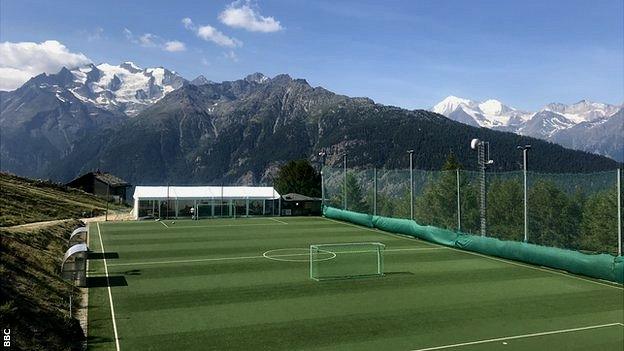Ottmar Hitzfeld Stadium: What's it like to play at Europe's 'highest' football stadium?
- Published
The Ottmar Hitzfeld Stadium - the 'highest' football stadium in Europe
It's so high that in winter it becomes a ski run and so remote that the pre-match journey has to be done by two cable cars.
It's remarkable the Ottmar Hitzfeld Stadium even exists at all.
The pitch is perched 2,000 metres above sea level, surrounded by peaks twice that high, in the Swiss Alps close to the resort of Zermatt.
"It is the most beautiful place you can play football," says FC Gspon defender Diego Abgottspon, who has played here for 18 years.
"You see the mountains, the glaciers, the trees - it is fantastic."
FC Gspon are an amateur team who play in the Swiss Mountain League and they proudly call their home ground the highest football stadium in Europe.
The village of Gspon - inaccessible by road - is made up of around 70 wooden chalets and in winter becomes a small ski resort. The air is thin and breathing can be more difficult than at your usual football ground.
"We are used to it," says Abgottspon, who plays for the club around being a ski instructor turned salesman.
"For the opponents it is harder. If we are 5-0 down at half-time we know we can come back and win.
"We are a team that is extremely strong in our home town."
The artificial pitch, smaller than your standard size because of the unsurprising lack of flat land, was built in 2009, 35 years after the club was formed.
The reasons for wanting to play here are clear, but it is not without its downsides.
A large net spans one side of the pitch and while it stops the ball disappearing down the mountainside most of the time, accidents can happen.
The estimation is the club has lost 1,000 balls in 40 years.

Gspon is in the Saas Valley, close to the ski resorts of Zermatt and Saas Fee
"Most of the time the balls travel about 100 metres down the hill - sometimes they're 200 or 300 metres further down," says defender Alfons Brigger.
"Sometimes there are games when you won't lose any balls or maybe one, then there are others when 10 balls go out and before our next training we have to go down there and look for them.
"It's quite annoying."
From October onwards the pitch is covered by thick snow - that is until the worst kind of pre-season training begins in late spring.
"We have to clear the pitch because up here it doesn't melt so good," Brigger says. "We have to put it all to the side of the pitch. That is the players' job.
"Normally there is half a metre on the pitch and we have to get it all off.
"It is really annoying and hard work."
Crowds at FC Gspon games range from as low as three or four in extreme weather to 40 or 50 in the height of summer, with spectators coming from Gspon or Staldenried, the larger, more developed village at the start of the five-minute cable ride below.
"Every time it is good weather it is really special to play here," says captain and midfielder Sebastian Furrer.
"My father also played here. I used to come up and watch him play and it is nice to be able to play where he played. It is a very special place."
The stadium is named after German former Switzerland and Bayern Munich manager Ottmar Hitzfeld, who took the ceremonial opening kick-off when it hosted the inaugural European Mountain Village Championship in 2008.
The tournament runs alongside the conventional European Championship every four years, with "mountain teams" representing nations from across the continent, and will return to Gspon in 2020.
Almost all who visit leave stunned by the ground's beauty.
"It is your hometown and it makes you proud that a lot of people think it is beautiful," Brigger says. "And of course it is - a beautiful view and beautiful village."